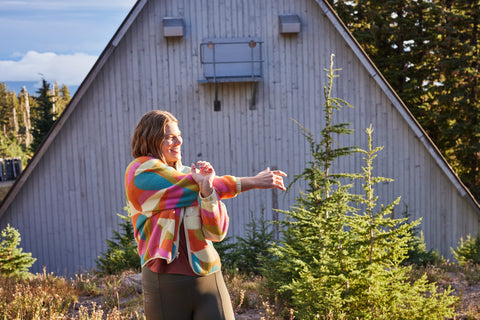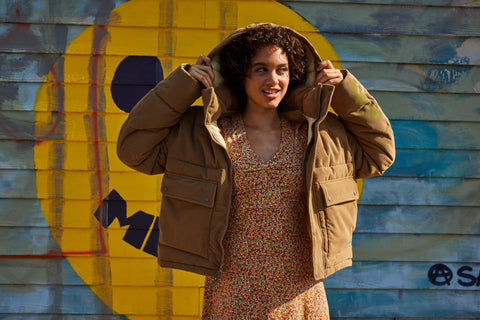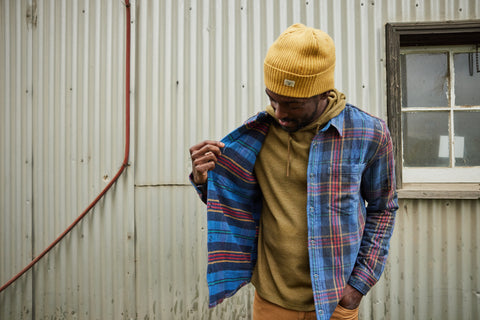Be a Layering Legend: How to Layer for Cold Weather

Layering is our favorite way to stylishly take the chill off any adventure. Not sure where to start? We’ve got you. Welcome to our warm (pun intended) and inviting guide to layering up during the fall and winter months.
How to Layer For Cold Weather
Layered outfits are best suited for changing weather conditions thanks to their ability for temperature control. Too warm? Unzip or shed a layer. Too cold? Add a layer. Here’s where it gets fun: from outdoor activities to work styling, the layering system is the same.
The Basics: How to Dress in Layers
Let’s start with the base layer, an essential for the coldest temperatures, but optional for mid-range temps. This breathable layer is meant to regulate the body temperature while wicking away sweat. Think of it as a second skin, generally worn snugly against the body. Wool, recycled polyester, and TENCEL™ Lyocell (especially with its bonus anti-stank properties) are fantastic fabric choices for base layers.
The mid-layer keeps you warm by adding insulation while also allowing heat to dissipate if needed. Fleece can be a great option. As a layering piece, it acts as cozy comfort that can hold in heat and be protected from the elements with a top layer. Fun fact: our ‘96 foundings started with fleece and these days, our Campo Fleece Collection is made from 100% recycled polyester.

Finish off with an outer layer that’s water-resistant or like curling up in your favorite sleeping bag (we’re looking at you, Spruce Wood Collection). This will keep the elements out and the coziness in.

We can take this layering system and easily apply it to everyday styling. Think of leggings as a base layer when the weather is frigid (hello TENCEL™ Lyocell Terrane Tights). From there, you can add pants, a skirt, or even a dress as your mid-layer. Pair it off with a wool sweater or button-down. Remember that the mid-layer will be visible, so pattern, color, and texture should all be considered.
Finally, finish it off with a jacket or cardigan for your outer layer, and consider a hat or scarf for extra warmth (peek the non-mulesed wool Cazadero Scarf and Chaparral Beanie). Yes, accessories can count as an outer-layer!

Layering A Dress For The Cold
Dress winterization is one of the easiest ways for an effortless, polished-looking outfit when it’s cold out. Leggings are a great and simple option for some extra warmth and comfort, whether they match or bring in pop of color or texture.
We also love a cozy pairing for a layered fall outfit, from cardigans, turtlenecks, and sweaters. If this mid-layer feels too bulky over a dress, try the belt trick. Comfortably cinch the belt over the sweater, then pull the sweater up slightly so it folds over the belt and hides it. Or wear the belt on the outside (the 90s are back!).
And, okay, we know this isn’t technically layering, but sweater dresses and sweatshirt dresses are a cozy standalone option that win every time.
Shirt Layering: More Than Just Tees and Sweaters
Getting creative with tops is also an easy way to up the outfit ante and layer for cold weather. Throw a jumper over a long sleeve or turtleneck, pick a button-up that adds texture, or layer it up with a fleece vest.
We’ll also let you in on another secret – you can layer long sleeves over each other! The base-mid-outer system works well with long sleeves, too. Try pairing a long sleeve tee with a heavier weight shirt jacket. The long sleeve tee acts as a base layer, while the shirt jacket doubles as a mid-or-outer layer. Or, a lightweight button-up with a heavier weight shirt jacket – the double button-up look keeps things interesting. Finally, try rocking a quarter zip under a cozy, insulated jacket for extra warmth and a pop of texture.

How to Layer Jackets Without the Bulk
Layered clothes shouldn’t make you feel “overstuffed.” Following the same principles of base-mid-outer, there are a few tricks to layering jackets without the bulk.
The ability to button or zip a jacket makes it an incredibly functional outer layer. You can bundle up from the elements or regulate your own temp by unzipping. With that in mind, wearing a sweater, quarter zip, or hooded sweatshirt as a mid-layer with your outer layer jacket gives you the most outfit flexibility.
More fitted clothing should be a base layer with heavier, looser pieces as a mid-or-outer layer. Think button-up, wool sweater, jacket. There’s a reason the layering system sticks with two to three pieces – oftentimes more than three layers is just too much for bulk and temperature.
The art and science of layering can take some time to perfect, but experimenting in your own closet can help make it a cinch. It’s also a great way to sort through your cold weather clothing, add any missing layers (we call this slow fashion meets function), and donate or sell anything that isn’t quite hitting the spot anymore. If you get stuck, peek the guide for some inspo to put together an aesthetically layered outfit.



